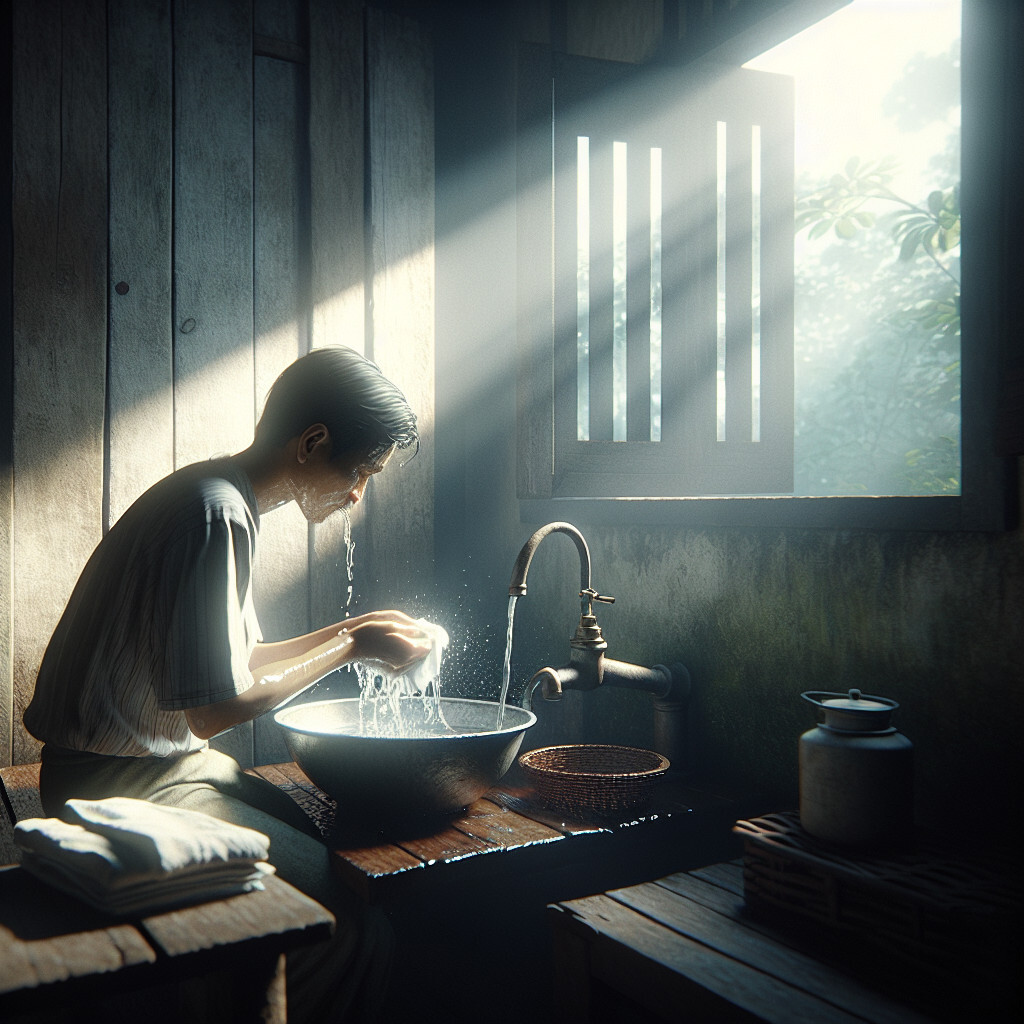-
Table of Contents
“Revolutionizing Cleanliness: Face Washing Beyond the Tap!”
Introduction

Washing your face without tap water can be a challenge, especially when you’re camping, traveling, or in a situation where clean running water is not readily available. However, it is not impossible. This guide will provide you with step-by-step instructions on how to cleanse your face using alternative methods and products, such as bottled water, facial wipes, micellar water, or even natural resources like rainwater or snow. These methods not only ensure your skin remains clean and healthy, but also help in reducing water wastage, making them environmentally friendly options.
Innovative Methods for Washing Your Face without Tap Water
In the realm of skincare, the importance of a clean face cannot be overstated. However, there are instances where access to tap water may be limited or non-existent. This could be due to a variety of reasons such as camping, traveling, or living in areas with water scarcity. In such situations, it becomes crucial to find innovative methods to maintain your skincare routine, specifically washing your face, without the use of tap water.
Firstly, one of the most effective and convenient methods is the use of micellar water. This product is a skincare marvel that originated in France and has gained global popularity due to its unique properties. Micellar water is made up of micelles, tiny balls of cleansing oil molecules, suspended in soft water. These micelles attract dirt and oil, making it an excellent choice for cleansing the skin. To use micellar water, simply soak a cotton pad and gently wipe it across your face. The beauty of this method is that it requires no rinsing, making it an ideal solution when tap water is not readily available.
Secondly, cleansing wipes are another practical option. These pre-moistened towelettes are designed to remove dirt, oil, and makeup from the skin. They are portable, easy to use, and require no rinsing. However, it is important to choose wipes that are alcohol-free and contain soothing ingredients like aloe vera or chamomile to prevent skin irritation.
In addition, facial cleansing powders are gaining popularity as a waterless option. These powders are activated by a small amount of any liquid, not necessarily water, and transform into a paste or foam that can be massaged onto the skin. After application, the product can be wiped off with a soft, damp cloth.
Moreover, the use of natural ingredients can also be explored. For instance, honey, known for its antimicrobial properties, can be used as a facial cleanser. Simply apply a thin layer of raw honey to slightly damp skin using a circular motion. Leave the honey for a few minutes before wiping off with a clean, dry cloth.
Lastly, the use of a thermal spring water spray can be considered. These sprays are rich in minerals and antioxidants that can cleanse and soothe the skin. After spraying, let it sit for a few minutes, then pat dry with a clean cloth.
In conclusion, while tap water is the most common medium for washing our faces, it is not the only option. The methods mentioned above not only provide alternatives in situations where tap water is unavailable but also offer a chance to experiment with different products and ingredients that could potentially be beneficial for your skin. However, it is important to remember that everyone’s skin is unique. What works for one person may not work for another. Therefore, it is always advisable to patch test any new product or ingredient on a small area of skin to ensure there is no adverse reaction. With these innovative methods, maintaining a clean and healthy complexion without tap water is not only possible but also achievable.
Exploring Natural Alternatives to Tap Water for Facial Cleansing
In the quest for maintaining a healthy and radiant complexion, the importance of facial cleansing cannot be overstated. However, the quality of water used in this routine is often overlooked. While tap water is the most common choice for many, it may not always be the best option. This is due to the presence of hard minerals, chlorine, and other impurities that can potentially harm the skin. Therefore, exploring natural alternatives to tap water for facial cleansing can be a game-changer for your skincare routine.
One of the most popular natural alternatives to tap water is distilled water. Distilled water is free from impurities and hard minerals that are typically found in tap water. It is gentle on the skin and can help maintain the skin’s natural pH balance. To use distilled water for facial cleansing, simply soak a soft cloth in the water and gently wipe your face. This method can be particularly beneficial for those with sensitive skin as it minimizes the risk of irritation.
Another excellent alternative is rose water. Known for its soothing and anti-inflammatory properties, rose water can cleanse the skin while providing a host of other benefits. It can help reduce redness, calm irritation, and even add a subtle glow to the skin. To cleanse your face with rose water, apply it to a cotton pad and gently sweep it across your face. This not only removes dirt and impurities but also leaves your skin feeling refreshed and rejuvenated.
For those seeking a more luxurious option, micellar water can be a great choice. Micellar water is a French skincare product that contains micelles, tiny balls of cleansing oil molecules, suspended in soft water. These micelles attract dirt and oil, making it easy to cleanse the skin without the need for rinsing. Micellar water is especially beneficial for dry and sensitive skin types as it cleanses without stripping the skin of its natural oils.
If you’re looking for a more eco-friendly option, rainwater can be a viable alternative. Rainwater is naturally soft and free from many of the impurities found in tap water. However, it’s crucial to ensure that the rainwater is collected and stored properly to avoid contamination. Once collected, it can be used in the same way as distilled water for facial cleansing.
Lastly, mineral water can also be used for facial cleansing. While it does contain minerals, these are typically beneficial for the skin. Mineral water can help to hydrate the skin and may even have anti-aging benefits. To use mineral water for facial cleansing, simply pour it onto a cotton pad and gently wipe your face.
In conclusion, while tap water is a convenient option for facial cleansing, it may not always be the best choice for your skin. By exploring natural alternatives such as distilled water, rose water, micellar water, rainwater, and mineral water, you can not only cleanse your skin effectively but also provide it with additional benefits. However, it’s important to remember that everyone’s skin is different, and what works for one person may not work for another. Therefore, it’s always a good idea to test these alternatives on a small patch of skin first to ensure they don’t cause any adverse reactions.
How to Cleanse Your Face Using Bottled and Distilled Water
Water is an essential element in our daily skincare routine. However, there are instances when tap water may not be readily available or suitable for use. In such cases, alternatives like bottled or distilled water can be employed to cleanse the face effectively. This article will guide you on how to wash your face without tap water, focusing on the use of bottled and distilled water.
Firstly, it is important to understand why one might opt for bottled or distilled water over tap water. Tap water often contains minerals and other impurities that can be harsh on the skin, leading to dryness, irritation, and even breakouts. On the other hand, bottled and distilled water are free from these impurities, making them a gentler option for facial cleansing.
To begin the process of washing your face with bottled or distilled water, you will need a clean washcloth, your preferred facial cleanser, and of course, your bottled or distilled water. It is advisable to use lukewarm water as it helps to open up the pores, allowing for a more thorough cleanse.
Start by wetting your face with a small amount of water. Apply your facial cleanser and gently massage it into your skin using circular motions. This helps to lift and remove dirt, oil, and makeup from the skin’s surface.
Once you’ve adequately massaged the cleanser into your skin, it’s time to rinse. Pour a generous amount of your bottled or distilled water onto your washcloth. Wring out the excess water and then gently wipe your face to remove the cleanser. Repeat this process until all the cleanser has been removed from your face.
It’s important to note that you should avoid scrubbing your face harshly with the washcloth. This can cause irritation and damage to the skin. Instead, use gentle, sweeping motions to cleanse your face.
After you’ve rinsed off the cleanser, pat your face dry with a clean towel. Avoid rubbing your skin as this can cause irritation and potentially lead to wrinkles. Once your face is dry, follow up with your regular skincare routine. This could include applying a toner, serum, moisturizer, or any other skincare products you typically use.
In conclusion, washing your face with bottled or distilled water can be a great alternative when tap water is not available or suitable for use. Not only does it provide a thorough cleanse, but it also offers a gentler option for those with sensitive skin. Remember, the key to effective facial cleansing lies in the technique – gentle, circular motions to apply the cleanser and soft, sweeping motions to rinse it off. By following these steps, you can maintain a healthy and glowing complexion, regardless of your water source.
The Ultimate Guide to Face Washing without the Use of Tap Water
The Ultimate Guide to Face Washing without the Use of Tap Water presents a unique perspective on maintaining facial hygiene when access to tap water is limited or unavailable. This could be due to a variety of reasons such as camping, traveling, or living in areas with water scarcity. Regardless of the circumstances, it is essential to keep your face clean to prevent the build-up of dirt, oil, and bacteria that can lead to skin problems.
The first alternative to tap water is using bottled water. It is a readily available resource and can be used in a similar manner to tap water. Simply pour a small amount into your hands, apply your regular facial cleanser, and gently massage it onto your face. Rinse by splashing the bottled water onto your face or use a clean, damp cloth to wipe off the cleanser. It’s important to note that while bottled water is a convenient option, it’s not the most environmentally friendly choice due to the plastic waste it generates.
Transitioning to the next option, micellar water is a fantastic alternative. Micellar water is a skincare product that contains tiny balls of cleansing oil molecules suspended in soft water. It’s designed to draw out impurities without drying out the skin, making it an excellent choice for face washing. To use micellar water, simply soak a cotton pad and gently wipe it across your face. There’s no need to rinse, making it a perfect option for on-the-go cleansing.
Another effective method is using facial cleansing wipes. These are pre-moistened with a cleansing solution and are designed to remove dirt, oil, and makeup without the need for water. They are portable, convenient, and come in a variety of types to suit different skin needs. However, they should not replace a regular face washing routine as they can leave residue on the skin. They are best used as a temporary solution or in conjunction with other cleansing methods.
If you’re looking for a more sustainable option, consider using a cleansing balm or oil. These products are designed to be massaged directly onto dry skin, breaking down makeup, dirt, and oil. Once you’ve massaged the product onto your skin, you can remove it with a damp, warm cloth. Not only does this method save water, but it also tends to be gentler on the skin, preventing the stripping of natural oils.
Lastly, a less conventional but effective method is using a facial steamer. This device releases warm steam that opens up the pores, allowing for a deep cleanse. After steaming, you can wipe your face with a clean towel to remove loosened dirt and oil. This method is particularly beneficial for those with oily or acne-prone skin.
In conclusion, there are numerous ways to wash your face without the use of tap water. Whether you choose bottled water, micellar water, facial wipes, a cleansing balm, or a facial steamer, the key is to find a method that suits your skin type and lifestyle. Remember, maintaining a regular cleansing routine is crucial for healthy skin, regardless of the resources available.
Q&A
1. Question: What can I use instead of tap water to wash my face?
Answer: You can use bottled or distilled water, micellar water, or facial cleansing wipes as alternatives to tap water.
2. Question: How can I wash my face with bottled water?
Answer: Pour a small amount of bottled water onto a clean washcloth, apply your usual facial cleanser, gently massage it onto your face, then rinse the washcloth and use it to wipe off the cleanser.
3. Question: Can I use micellar water to clean my face?
Answer: Yes, micellar water is a great alternative to tap water. Simply apply it to a cotton pad and gently wipe your face. It doesn’t require rinsing.
4. Question: Are facial cleansing wipes effective for washing face without tap water?
Answer: Yes, facial cleansing wipes can effectively remove dirt and oil from your skin. However, they may not provide as deep a cleanse as traditional washing, so they’re best used as a temporary solution.
Conclusion
In conclusion, washing your face without tap water can be achieved by using alternatives such as bottled water, cleansing wipes, micellar water, or a no-rinse facial cleanser. These methods can effectively clean your face, remove makeup, and maintain skin hygiene when tap water is not available.






